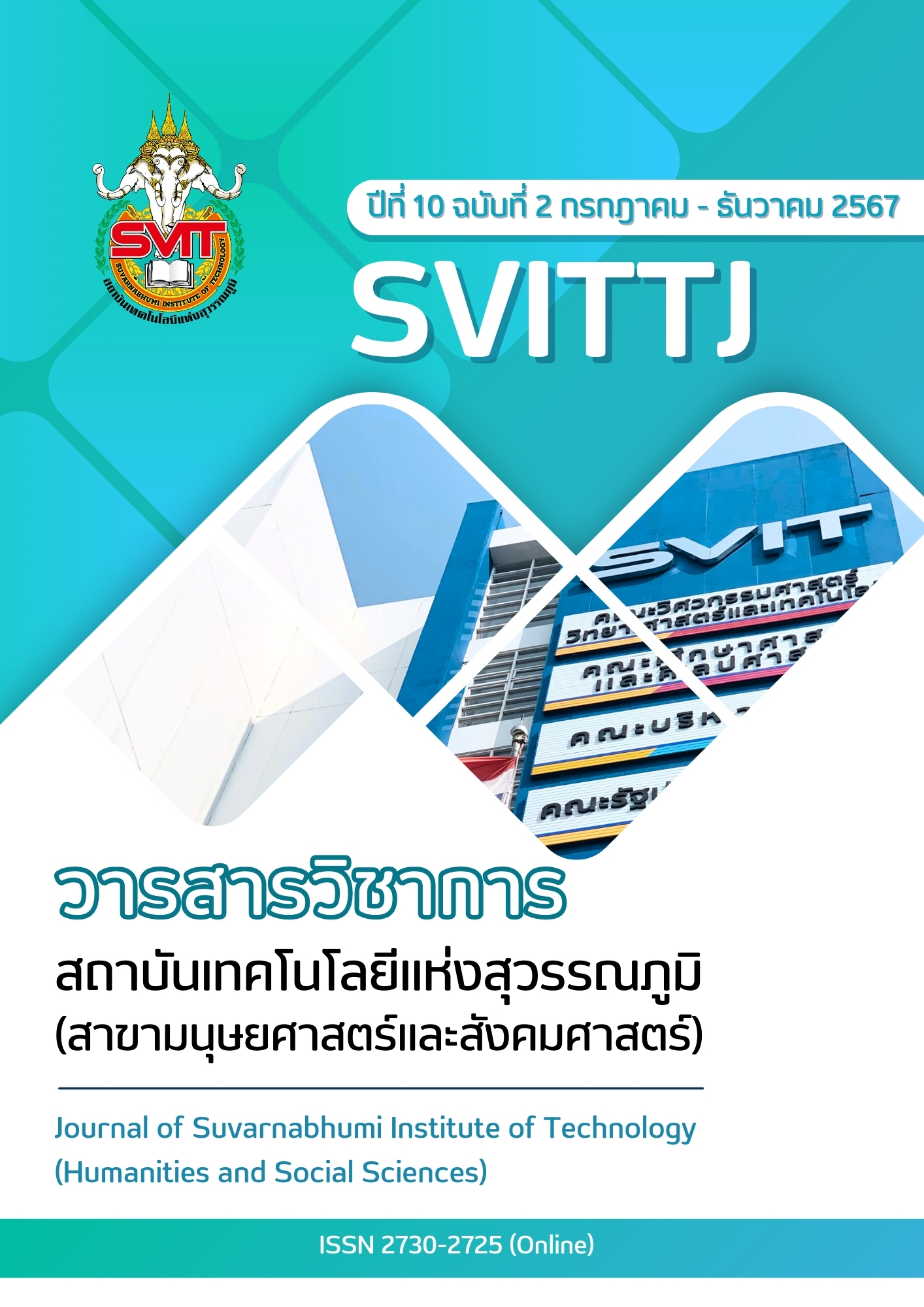HOW POSTGRADUATE STUDENTS ADOPT LIVESTREAM SHOPPING?: A CASE STUDY IN CHENGDU, CHINA
คำสำคัญ:
Livestreaming Shopping, Behavioral Intention, Perceived Enjoyment, Attitudeบทคัดย่อ
This study intends to investigate the factors influencing the choice of livestream shopping among postgraduate students in Chengdu. Seven variables are perceived ease of use, perceived usefulness, perceived enjoyment, attitude, service quality, social influence, and behavioral intention. The researcher applied the quantitative method (n=500), distributing questionnaires to postgraduate students in three designated universities in Chengdu. The Structural Equation Model (SEM) and Confirmatory Factor Analysis (CFA) were used for the data analysis, and they included model fit, reliability, and validity of the constructs. The results explicated that perceived ease of use, usefulness, and enjoyment significantly impact attitude. Attitude, service quality, and social influence positively affect behavioral intention. Eight hypotheses were completely proven to fulfill research objectives. Hence, we need to observe how the different variables influence the customers’ behavioral intention and work less with a higher efficiency.
เอกสารอ้างอิง
Addo, P., Fang, J., Asare, A., & Kulbo, N. (2021). Customer engagement and purchase intention in live-streaming digital marketing platforms. The Service Industries Journal, 41(2), 1-20. https://doi.org/10.1080/02642069.2021.1905798
Ahn, J., & Back, K.-J. (2019). Effects of Integrated Resort Experience on Customers’ Hedonic and Eudaimonic Well-Being. Journal of Hospitality & Tourism Research, 43(8), 1-11.
Ajzen, I., & Fishbein, M. (1980). Understanding Attitudes and Predicting Social Behavior (1st ed.). Prentice-Hall, Englewood Cliffs.
Al-Mamary, Y. H., & Shamsuddin, A. (2015). Testing of the Technology Acceptance Model in Context of Yemen. Mediterranean Journal of Social Sciences, 2(1), 11-23. https://doi.org/10.5901/mjss.2015.v6n4s1p268
Awang, Z. (2012). Structural equation modeling using AMOS graphic (1st ed.). Penerbit Universiti Teknologi MARA.
Bagozzi, R. P., & Dholakia, U. M. (2002). Intentional social action in virtual communities. Journal of Interactive Marketing, 16(2), 2-21. https://doi.org/10.1002/dir.10006
Barro, R. J., Ursua, J. F., & Weng, J. (2020). The Coronavirus and the Great Influenza Pandemic: Lessons from the “Spanish Flu” for the Coronavirus’s Potential Effects on Mortality and Economic Activity. National Bureau of Economic Research, 11(2), 20-25. https://doi.org/10.2139/ssrn.3556305
Bentler, P. M. (1990). Comparative fit indexes in structural models. Psychological Bulletin, 107(2), 238. https://doi.org/https://doi.org/10.1037/0033-2909.107.2.238
Chen, C.-F., & Chen, F.-S. (2010). Experience quality, perceived value, satisfaction, and behavioral intentions for heritage tourists. Tourism Management, 31(1), 29-35. https://doi.org/10.1016/j.tourman.2009.02.008
CNNIC. (2018). The 41st “Statistical Report on the Development of China’s Internet.
http://www.cnnic.net.cn/hlwfzyj/hlwxzbg/hlwtjbg/201803/t20180305_70249.htm
Davis, F., Bagozzi, R., & Warshaw, P. (1989). User Acceptance of Computer Technology: A Comparison of Two Theoretical Models. Management Science, 35(8), 982-1003. https://doi.org/10.1287/mnsc.35.8.982
Davis, F. D. (1989). Perceived Usefulness, Perceived Ease of Use, and User Acceptance of Information Technology. MIS Quarterly, 13(3), 319-340. https://doi.org/10.2307/249008
Davis, F. D., Bagozzi, R. P., & Warshaw, P. R. (1992). Extrinsic and Intrinsic Motivation to Use Computers in the Workplace. Journal of Applied Social Psychology, 22(14), 1111-1132. https://doi.org/10.1111/j.1559-1816.1992.tb00945.x
Deci, E. (1975). Intrinsic Motivation. Plenum Press.
https://doi.org/10.1007/978-1-4613-4446-9
Dimitrova, D., & Chen, Y.-C. (2006). Profiling the Adopters of E-Government Information and Services. Social Science Computer Review, 24(2), 172-188. https://doi.org/10.1177/0894439305281517
Fishbein, M., & Ajzen, I. (1975). Belief, Attitude, Intention, and Behavior: An Introduction to Theory and Research. Addison-Wesley.
Fornell, C., & Larcker, D. F. (1981). Evaluating structural equation models with unobservable variables and measurement error. Journal of marketing Research, 18(1), 39-50. https://doi.org/10.1177/002224378101800104
Greenberg, O. W. (1964). Spin and Unitary-Spin Independence in a Paraquark Model of Baryons and Mesons. Physical Review Letters, 13(20), 598-602. https://doi.org/10.1103/physrevlett.13.598
Greenspoon, P. J., & Saklofske, D. H. (1998). Confirmatory factor analysis of the multidimensional Students' Life Satisfaction Scale. Personality and Individual Differences, 25(5), 965–971. https://doi.org/10.1016/S0191-8869(98)00115-9
Hair, J., Black, W., Babin, B., Anderson, R., & Tatham, R. (2006). Multivariate Data Analysis (6th ed.). Pearson Prentice Hall.
Han, J., Nunes, J., Drèze, X., & Marshall, A. (2010). Signaling Status with Luxury Goods: The Role of Brand Prominence. Journal of Marketing, 74(4), 1547-7185. https://doi.org/10.1509/jmkg.74.4.15
Hassan, M., Nawaz, M. S., Abbas, G., & Sajid, M. I. (2013). Impact of high-performance work practices on employee loyalty and financial performance through mediation of employee satisfaction: Empirical evidence from the financial sector of Pakistan. Middle East Journal of Scientific Research, 16(8), 1037-1046.
Hoffman, M. L. (2000). Empathy and moral development: Implications for caring and justice (1st ed.). Cambridge University Press. https://doi.org/10.1017/CBO9780511805851
Hsu, Y.-C., Hung, J.-L., & Ching, Y.-H. (2013). Trends of educational technology research: more than a decade of international research in six SSCI-indexed refereed journals. Educational Technology Research and Development, 61(4), 685-705. https://doi.org/10.1007/s11423-013-9290-9
Huang, L. Y., Hsieh, Y. J., & Wu, Y. C. J. (2014). Gratifications and Social Network Service Usage: The Mediating Role of Online Experience. Information and Management, 51, 774-782. https://doi.org/10.1016/j.im.2014.05.004
Jones, S. M., Lesaux, N. K., Gonzales, K. E., Hanno, E. C., & Guzman, R. (2020). Exploring the role of quality in a population study of early education and care. Early Childhood Research Quarterly, 53(4), 551-570.
Kim, J., & Forsythe, S. (2008). Adoption of Virtual Try-on technology for online apparel shopping. Journal of Interactive Marketing, 22(2), 45-59. https://doi.org/10.1002/dir.20113
Kotler, P., & Keller, K. (2014). Marketing Management (15th ed.). Prentice Hall, Saddle River.
Kwon, J., & Lee, K. M. (2010). Visual tracking decomposition (1st ed.). 2010 IEEE Computer Society Conference on Computer Vision and Pattern Recognition. https://doi.org/10.1109/cvpr.2010.5539821
Lin, H.-H., Wang, Y.-S., & Chang, L.-K. (2011). Consumer responses to online retailer's service recovery after a service failure: A perspective of justice theory. Managing Service Quality: An International Journal, 21(5), 511-534. https://doi.org/10.1108/09604521111159807
Lin, K. Y., & Lu, H. P. (2011). Why People Use Social Networking Sites: An Empirical Study Integrating Network Externalities and Motivation Theory. Computers in Human Behavior, 27, 1152-1161. http://dx.doi.org/10.1016/j.chb.2010.12.009
Mao, E., & Palvia, P. (2006). Testing an Extended Model of IT Acceptance in the Chinese Cultural Context. ACM SIGMIS Database, 37(2-3), 20-32. https://doi.org/10.1145/1161345.1161351
Ndubisi, N. O. (2003). Relationship marketing and customer loyalty. Emerald insight, 25(1), 98-106. https://doi.org/10.1108/02634500710722425
Nunnally, J. C., & Bernstein, I. H. (1994). Psychometric theory (3rd ed.). McGraw-Hill.
Oliver, R. L. (2010). Satisfaction: A Behavioral Perspective on Consumer (2nd ed.). Routledge.
Parasuraman, A., Zeithaml, V. A., & Berry, L. L. (1988). SERVQUAL: A Multiple-Item Scale for Measuring Consumer Perceptions of Service Quality. Journal of Retailing, 64, 12-40.
Park, D.-H., Lee, J., & Han, I. (2007). The Effect of On-Line Consumer Reviews on Consumer Purchasing Intention: The Moderating Role of Involvement. International Journal of Electronic Commerce, 11(4), 125-148. https://doi.org/10.2753/jec1086-4415110405
Pedroso, R., Zanetello, L., Guimarães, L., Pettenon, M., Gonçalves, V., Scherer, J., Kessler, F., & Pechansky, F. (2016). Confirmatory factor analysis (CFA) of the Crack Use Relapse Scale (CURS). Archives of Clinical Psychiatry (São Paulo), 43(3), 37-40. https://doi.org/10.1590/0101-60830000000081
Pervin, L. A., Cervone, D., & John, O. P. (2005). Personality: theory and research (1st ed.). John Wiley & Sons, Inc
Research & Markets. (2016). Trusted by the World’s Leading Brands. https://www.researchandmarkets.com/
Safari, K., Bisimwa, A., & Buzera, M. (2020). Attitudes and intentions toward internet banking in an under developed financial sector. PSU Research Review, 6(1), 39-58. https://doi.org/10.1108/PRR-03-2020-0009.
Schepers, J., & Wetzels, M. (2007). A meta-analysis of the technology acceptance model: Investigating subjective norm and moderation effects. Information & Management, 44(1), 90-103. https://doi.org/10.1016/j.im.2006.10.007
Seddon, P., & Kiew, M.-Y. (1996). A Partial Test and Development of Delone and Mclean's Model of IS Success. Australasian Journal of Information Systems, 4(1), 1-10. https://doi.org/10.3127/ajis.v4i1.379
Sharma, S., Mukherjee, S., Kumar, A., & Dillon, W. R. (2005). A simulation study to investigate the use of cutoff values for assessing model fit in covariance structure models. Journal of Business Research, 58(7), 935-943. https://doi.org/10.1016/j.jbusres.2003.10.007
Sica, C., & Ghisi, M. (2007). The Italian versions of the Beck Anxiety Inventory and the Beck Depression Inventory-II: Psychometric properties and discriminant power. In M. A. Lange (Ed.), Leading - Edge Psychological Tests and Testing Research (pp. 27-50). Nova..
Sjöblom, M., Törhönen, M., Hamari, J., & Macey, J. (2018). The ingredients of Twitch streaming: Affordances of game streams. Computers in Human Behavior, 92, 20-28. https://doi.org/10.1016/j.chb.2018.10.012
Smith, V., Devane, D., & Clarke, M. (2011). Methodology in conducting a systematic review of systematic reviews of healthcare interventions. BMC Medical Research Methodology, 11(15), 1-20. https://doi.org/10.1186/1471-2288-11-15
Solomon, M. R. (2004). Consumer Behavior, Buying, Having and Being (6th ed.). Pearson Prentice Hall.
Suki, N. M. (2011). Exploring the Relationship between Perceived Usefulness, Perceived Ease of Use, Perceived Enjoyment, Attitude and Subscribers’ Intention towards Using 3G Mobile Services. Journal of Information Technology Management, 22, 1-7.
Teo, T. S. H., Lim, V. K. G., & Lai, R. Y. C. (1999). Intrinsic and extrinsic motivation in Internet usage. Omega, 27(1), 25-37. https://doi.org/10.1016/s0305-0483(98)00028-0
Udo, G. J., Bagchi, K. K., & Kirs, P. J. (2010). An assessment of customers' e-service quality perception, satisfaction, and intention. International Journal of Information Management, 30(6), 481-492. https://doi.org/10.1016/j.ijinfomgt.2010.03.005
Venkatesh, V., & Davis, F. D. (2000). A Theoretical Extension of the Technology Acceptance Model: Four Longitudinal Field Studies. Management Science, 46(2), 186-204. https://doi.org/10.1287/mnsc.46.2.186.11926
Venkatesh, V., Morris, M. G., Davis, G. B., & Davis, F. D. (2003). User Acceptance of Information Technology: Towards a Unified View. MIS Quarterly, 27, 425-478. https://doi.org/10.2307/30036540
Venkatesh, V., Thong, J., & Xu, X. (2012). Consumer Acceptance and Use of Information Technology: Extending the Unified Theory of Acceptance and Use of Technology. MIS Quarterly, 36(1), 157-178. https://doi.org/10.2307/41410412
Wang, J. Y., Wang, S. J., & Feng, K. S. (2019). Coupling analysis of urbanization and energy-environment efficiency: Evidence from Guangdong province. Applied Energy, 254, Article 113650. https://doi.org/10.1016/j.apenergy.2019.113650
Wang, K., & Zhu, C. (2019). MOOC-based flipped learning in higher education: students’ participation, experience and learning performance. International Journal of Educational Technology in Higher Education volume, 16, 1-10. https://doi.org/10.1186/s41239-019-0163-0
Wangpipatwong, S., Chutimaskul, W., & Papasratorn, B. (2008). Understanding Citizen's Continuance Intention to Use e- Government Website: A Composite View of Technology Acceptance Model and Computer Self-Efficacy. Electronic Government, an International Journal, 6, 1-10.
Warshaw, P. R., & Davis, F. D. (1985). Disentangling behavioral intention and behavioral expectation. Journal of Experimental Social Psychology, 21(3), 213–228. https://doi.org/10.1016/0022-1031(85)90017-4
Wong, J. K. W., & Zhou, J. (2015). Enhancing Environmental Sustainability over Building Life Cycles through Green BIM: A Review. Automation in Construction, 57, 156-165. https://doi.org/10.1016/j.autcon.2015.06.003
Wu, J.-H., & Wang, Y.-M. (2006). Measuring KMS success: A specification of the DeLone and McLean's model. Information & management, 43(6), 728-739. https://doi.org/10.1016/j.im.2006.05.002
Wu, X., Yang, H., Waugh, D. W., Orbe, C., Tilmes, S., & Lamarque, J.-F. (2018). Spatial and temporal variability of interhemispheric transport times. Atmospheric Chemistry and Physics, 18(10), 7439-7452. https://doi.org/10.5194/acp-18-7439-2018
Yi, M., Jackson, J., Park, J., & Probst, J. (2006). Understanding Information Technology Acceptance by Individual Professionals: Toward an Integrative View. Information & Management, 43(3), 350-363. https://doi.org/10.1016/j.im.2005.08.006
Zeithaml, V. A. (1988). Consumer Perceptions of Price, Quality, and Value: A Means-End Model and Synthesis of Evidence. Journal of Marketing, 52, 2-22. http://dx.doi.org/10.2307/1251446
Zeithaml, V. A., Berry, L. L., & Parasuraman, A. (1993). The Nature and Determinants of Customer Expectation of Service. Journal of the Academy of Marketing Science, 21, 1-12. http://dx.doi.org/10.1177/0092070393211001
Zeithaml, V. A., & Bitner, M. J. (1996). Services Marketing (1st ed.). McGraw-Hill.
Zeithaml, V. A., Bitner, M. J., & Gremler, D. D. (2009). Service marketing: integrating customer focus across the firm (5th ed.). McGraw-Hill/Irwin.
Zhang, J., & Mao, E. (2008). Understanding the Acceptance of Mobile SMS Advertising among Young Chinese Consumers. Psychology and Marketing, 25, 787-805.
https://doi.org/10.1002/mar.20239
Zhou, M., & Ee, J. (2012). Development of the Social Emotional Competence Questionnaire (SECQ). The International Journal of Emotional Education, 4, 27-42. https://doi.org/10.1037/t69172-000
ดาวน์โหลด
เผยแพร่แล้ว
ฉบับ
ประเภทบทความ
สัญญาอนุญาต
ลิขสิทธิ์ (c) 2024 สถาบันเทคโนโลยีแห่งสุวรรณภูมิ

อนุญาตภายใต้เงื่อนไข Creative Commons Attribution-NonCommercial-NoDerivatives 4.0 International License.
บทความที่ได้รับการตีพิมพ์เป็นลิขสิทธิ์ของวารสารวิชาการ สถาบันเทคโนโลยีแห่งสุวรรณภูมิ
ข้อความที่ปรากฏในบทความแต่ละเรื่องในวารสารวิชาการเล่มนี้เป็นความคิดเห็นส่วนตัวของผู้เขียนแต่ละท่านไม่เกี่ยวข้องกับสถาบันเทคโนโลยีแห่งสุวรรณภูมิ และคณาจารย์ท่านอื่นๆในสถาบันฯ แต่อย่างใด ความรับผิดชอบองค์ประกอบทั้งหมดของบทความแต่ละเรื่องเป็นของผู้เขียนแต่ละท่าน หากมีความผิดพลาดใดๆ ผู้เขียนแต่ละท่านจะรับผิดชอบบทความของตนเองแต่ผู้เดียว





